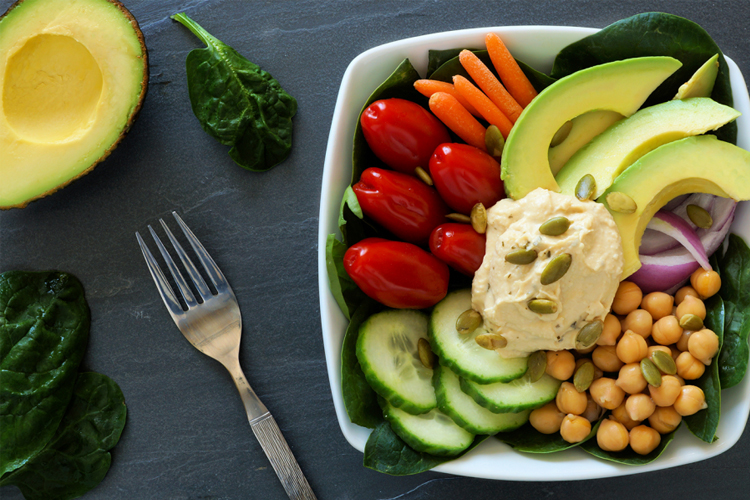With the continued excitement for eating low-carb and Paleo–two diets known for having higher protein intake– the popularity of protein is reigning high. As you undergo your weight loss journey, you might question why protein is so prized. How does it really help you lose weight? Here are 5 reasons why protein can be your weight loss pal:
1. PROTEIN SATISFIES & SAVES CALORIES In the beginning of your weight loss journey, protein is important because it helps you feel fuller longer. Having protein around slows down digestion making us more satisfied and less likely to go back for seconds. If this happens over the course of multiple days your calorie savings can help with weight loss.
2. IT CURBS CARB HIGHS AND LOWS I don’t know about you, but when I come off a sugar high onto a sugar low I can make food decisions I’ll later regret (here’s looking at you, last breakroom donut). Pairing protein with carbohydrate-rich foods slows down the absorption of sugar from your stomach into your bloodstream, which may help keep your blood sugar from skyrocketing and ward off future cravings.
3. PROTEIN REQUIRES MORE OF YOUR ENERGY The “thermic effect of food” (TEF) is the energy we use to digest food into small, absorbable components. Protein has a higher TEF compared to carbs and fat meaning you’re actually burning more calories to process protein than to process the other two.
4. IT FUELS FAT BURNING It may be surprising, but it is a scientific fact that your body cannot effectively burn and use fat as energy if it doesn’t have help from either carbohydrate or protein. As you are losing weight, your body loses both muscle and fat (I know, bummer!). During this process it is especially important that you continue to eat enough protein in your diet. Having adequate protein coming in from your food fuels fat burning while preserving calorie-burning lean muscle.
5. PROTEIN PROMOTES MUSCLE REPAIR & GROWTH Your protein needs increase especially after bouts of intense exercise so increasing your protein intake on days that you exercise is beneficial. Additionally, if you strength train consider having a high protein snack right after a training session when the muscle is sensitive to nutrients that it can use to repair and grow.
One important thing to realize is eating more protein alone won’t necessarily help you shed excess weight in a healthy way. When consumed in excessive amounts it can still lead to weight gain much like eating excess carbs or fat would, and could put unnecessary strain on the kidneys over a long period of time.
But, you can still make protein a pal on your weight loss journey by getting enough protein in your daily diet. MyFitnessPal sets your protein to be 20% of your total calories, which should be enough for the average person.
Want more information about protein and tips on how to choose the healthiest forms? Check out this great infographic, and some of our high-protein recipes.
Written by My Fitness Pal
Most of us, particularly if we struggle with our weight goals, have blamed the dreaded “metabolism” monster: “It’s too slow,” we say. We often target it as a common weight-loss enemy without truly knowing the factors that play into metabolism—and whether or not we can change them.
3 Major Things that Determine Your Metabolism
Metabolism refers to the process of converting the calories you eat into energy to power all of your bodily processes. Your metabolism determines the amount of calories you can eat all day and still maintain your weight. It’s affected by three major things:
- Basal metabolic rate (BMR): Tells you the number of calories needed to maintain your body in a rested, fasting state. It’s affected by your gender, age, size, muscle mass, genetics and health-related factors. Your BMR accounts for 60-70% of the total calories you burn each day.
- Activity level: Tells you the number of calories you use up during exercise. Your activity level accounts for about 20% of the total calories you burn each day.
- Food thermogenesis: Tells you the number of calories you need to digest and absorb your food. It accounts for about 10% of the total calories you burn each day.
Anything that affects the three major things mentioned above would change the amount of calories you need to maintain your body weight. Your basal metabolic rate is adaptable, and it will increase or decrease to provide for your body’s needs. For example:
- Your metabolism dials up and burns more calories during a fever or infection to help you heal.
- Your metabolism dials down and burns less calories during a long fast to conserve calories and prevent you from wasting away.
How Aging Affects Metabolism
If you’re a healthy adult, your metabolism is likely a-okay. Instead of blaming thyroid diseases, relatively rare culprits of a slowed metabolism, you should consider how aging slows metabolism—and implement strategies to fight back. Aging happens to everyone, and it’s usually accompanied by a decrease in BMR. Why?
Our BMR is naturally at its highest during childhood and adolescence, mainly because we need the extra calories to grow and mature into adulthood. Once we reach our 20s, this phase is complete and our BMR levels off. The trend here on out is sneaky, steady weight gain over the course of decades. Research published in the New England Journal of Medicine revealed the weight-gain trends of 120,000 participants for up to 20 years. Scientists found that participants gained about 3.4 pounds (1.5 kilograms) each over a four-year period, which translates to a gain of 16.8 pounds (7.6 kilograms) over 20 years.
The biggest issue isn’t so much the weight gain, but the type of weight we tend to gain as we age; most of us tend to lose lean muscle mass and correspondingly replace it with fat. In a typical young adult, lean muscle mass makes up about 50% of total body weight, which declines to about 25% of total body weight when that individual reaches 75-80 years old. Having lower lean muscle mass decreases our BMR since, pound for pound, it takes more energy to maintain muscle compared to fat.
Don’t get me wrong! Having a protective amount of fat is a good thing, especially when we hit an older age, which is why adults aged 65 and older are advised to maintain a BMI between 25 to 27, instead of the 18.5 to 24.9 recommendation for the rest of us. The goal, of course, is to maintain as much lean muscle mass as possible since doing so would…
- Stop your BMR from declining. It has been shown time and again that BMR naturally decreases as we age. But, if you can maintain or build upon the muscle mass that you have, you’ll have a higher BMR (compared to if you took no action).
- Preserve your muscles’ ability to propel you through all of life’s activities. Even if you don’t care about your metabolism, aim to maintain and build muscle because this allows you to live your life to the fullest. Muscles are involved in every movement you make, from playing with your child to carrying a load of groceries.
Ways to Combat a Slowing Metabolism
- Aim to strength train at least 2-3 times per week (hint, hint: This is the most important tip!). Whether you’re a gal or guy, prioritize weight lifting in your exercise plan. Adding muscle mass increases your BMR, allowing you to burn more calories even when you’re not exercising. If you’re a newbie to strength training, check out So You Want to Start…Strength Training.
- Ramp up the intensity of your aerobic exercise (think running, swimming, biking faster). Exercising at higher intensities allows you to reap the benefits of “after burn,” a phenomena where you burn extra calories post-exercise. To benefit from this effect, you should run, jump, dance, swim, bike, etc. at a pace where it’s difficult to talk. If you can push a little harder, then do so.
- Eat enough protein from high-quality sources. High-quality protein sources supply amino acids to your muscles post-exercise so that they can repair and grow. To learn more about how to determine your protein needs, check out this Beginner’s Guide to Protein.
- Stay well hydrated. Water is important because all of the chemical reactions in your body requires water—including the ones that burn calories. To work on drinking more water each day, check out 20 Lifehacks for Drinking More Water.
- Don’t starve yourself in order to lose weight. You need to consume a moderate amount of calories in order to lose weight. If you eat a significantly low amount of calories, you’ll lose weight rapidly but much of it will be from water and muscle loss. Plus, you’ll likely lose hard-earned muscle mass that’s responsible for maintaining a higher BMR.
Written By My Fitness Pal
Plateaus are usually associated with stunning views. Think of the Massif Central in France, the Tibetan Plateau, and the Colorado Plateau, all with infinite views from any point that the landscape meets the sky. But a diet plateau? Not so much.
When diet and exercise ceases to result in the weight loss trajectory you’ve gotten used to, the plateau is a desolate and brooding place. What is a diet plateau? Typically, your body adjusts to all your hard work and resets its response to your efforts, slowing down your metabolism and, hence, slowing down your weight loss. Whenever this happens, and it happens to most people on any long-term diet and exercise plan, the plateau is a challenging place to land. What to do?
First of all, try not to go negative. You’ve already accomplished so much in terms of your goals. This is hard advice to follow, I must admit, but negativity won’t help you accomplish your#ResolutionReset, that’s for certain.
I hit a plateau about three weeks in, after losing six pounds, which exceeded my goal of one pound per week, up to that point. Here’s what has helped me get back on track:
Drinking more water. I try to drink eight glasses of water a day, but I don’t always. Increasing my intake of pure water helped me feel full and it helped me detox, flushing out toxins and reducing cravings.
Taking a break from the scale. It sounds counter-intuitive, but daily weigh-ins started to get me down, so I shifted to weekly, and at the end of my week of fine-tuning my diet and exercise, I’d actually lost 1.5 more pounds. Not as much as the two per week I’d started out with, but not too shabby.
Focus on specific food choices. I’ve found that when I eat more protein, my metabolism speeds up. Everyone is different, but fewer carbs have resulted in greater success for me.
Eat clean. What I mean by this is an attempt to avoid processed foods, choosing instead whole grains, vegetables, and high-nutrient foods of all kinds.
Maximize exercise. When I began to look at how I could ramp up my workouts without spending more time in the gym or out on my bike, I realized that I could increase my intensity, add hills, and take fewer breaks, all of which seemed to boost my fat-burning power.
Whatever your approach, experiment with both diet and exercise modifications and see how your body and mind respond.
Written By My Fitness Pal
What are dietary supplements?
The Food and Drug Administration defines a dietary supplement as something taken to add nutritional value on top of the foods you eat on a regular basis. In addition to carbohydrates, protein and fat, our amazing body requires dozens of vitamins and minerals to function properly. Depending on your lifestyle, you may or may not be able to obtain all these nutrients from food. (However, like most experts, I recommend you improve your eating habits before considering supplements.)
It’s not always a clear choice. Some of us voluntarily seek out supplements to enhance our current health, prevent future issues or improve physical appearance. Others take supplements out of medical necessity such as correcting a nutrient deficiency. If you’re unsure of how to make that choice, please consult your health-care professional, so he or she can help navigate your individual case.
The Calorie Counts in Supplements
As a MyFitnessPal user, you understand that calories and macronutrients (Think: carbohydrates, fat and protein) are critical for success. Depending on which dietary supplements you take, the calorie count will vary. Here is a brief summary:
- Micronutrient supplements: Once isolated from food, vitamins and minerals don’t contribute calories. However, when they are made into pills, soft chews or gummies, additives such as sugar or oils may be included. Calories from micronutrient supplements are fairly small — most range from 5–30 calories if you take the recommended amount.
- Fat-based supplements: This category includes omega-3 or -6 fatty-acid capsules, conjugated linoleic acid, flaxseed and fish and krill oil, to name a few. Fat-based supplements range from 15–45 calories if you take the recommended amount.
- Carbohydrate-based supplements: Fiber supplements are common in this category and range from 15–80 calories if you take the recommended amount.
- Protein-based supplements: Of all the categories, only protein-based supplements confer a sizable amount of calories. Protein bars and powders range have the most!
*Before mixing with milk.
The Verdict
With the exception of protein powders and bars, dietary supplements don’t provide all that many calories. If you’re taking protein-based supplements, especially multiple times per day, then it’s a good idea to keep track. For the other types of supplements, it’s totally up to you! A perk of tracking is that it helps you remember that you already took a supplement that day.
MyFitnessPal makes it simple to keep track of your dietary supplements. Here’s my suggestion:Create an extra meal, and title it “Supplements.” You can log all your supplements here. The best part is that the app will remember the supplements you regularly log, making it super easy to add your supplements consistently to your food diary. To set this up, follow two steps:
1. Log in to MyFitnessPal. To get started, you’ll need to access your MyFitnessPal account in a web browser. If you predominantly use the web version of MyFitnessPal, you may have already figured out how to rename your meals. For those of you on mobile only, here’s a reason to get cozy with your computer for a few minutes.
2. Add and rename meals. Once you’ve logged in, click “My Home,” then “Settings,” then “Diary Settings.” There you can add another meal and title it “Supplements.” The next time you log in on the web or one of our mobile apps, your diary will reflect the changes.
Written By My Fitness Pal




